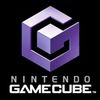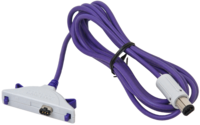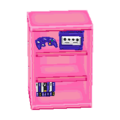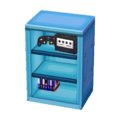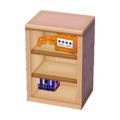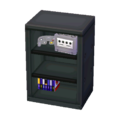Difference between revisions of "Nintendo GameCube"
(Removing info about the GameCube's competitors as part of the community agreement.) |
PanchamBro (talk | contribs) |
||
| Line 21: | Line 21: | ||
}} | }} | ||
[[File:GameCube Square Logo.jpg|left|100px]] | [[File:GameCube Square Logo.jpg|left|100px]] | ||
| − | The '''Nintendo GameCube'''{{Note|{{Nihongo foot|ニンテンドーゲームキューブ|Nintendou Geimukyuubu}}}} (officially abbreviated as '''GCN''') is [[ | + | The '''Nintendo GameCube'''{{Note|{{Nihongo foot|ニンテンドーゲームキューブ|Nintendou Geimukyuubu}}}} (officially abbreviated as '''GCN''') is a home video game console created by [[Nintendo]]. It is the successor to the [[Nintendo 64]] and predecessor to the [[Wii]]. The Nintendo GameCube is the first Nintendo console to use discs as its game type, albeit with discs similar to mini DVDs, as they were 8cm in diameter. In addition, the GameCube also introduced a variety of connectivity options to Nintendo consoles, and was the third Nintendo console, after the [[Wikipedia:Nintendo 64DD|Nintendo 64DD]], to support online play officially, via the Nintendo GameCube Broadband Adapter and Modem Adapter, although only a few games supported it. It also enabled connectivity to the Game Boy Advance to access exclusive features of certain games or to use the portable system as a controller for the Game Boy Player. |
| + | |||
| + | {{PG}}, an expanded version of {{DnM}}, was released on the GameCube in 2001 and was later expanded and re-released in Japan as {{DnMe+}} in 2003. Additionally, ''[[Super Smash Bros. Melee]]'', which features trophies from the {{SER}}, was released on the console in 2001 and later became the console's best-selling game. | ||
| + | |||
| + | The console was released on September 14, 2001 in Japan, November 18, 2001 in North America, May 3, 2002 in Europe, and May 17, 2002 in Australia. The GameCube sold 21.74 million units worldwide, and was discontinued in mid-2007. The GameCube's games and controllers are also backwards-compatible with the original model of its successor, the Wii. Future Nintendo consoles, such as the [[Wii U]] and [[Nintendo Switch]], only have support for the GameCube Controllers through the use of a USB adapter, although the Wii U can only use the GameCube Controllers for {{SSB4|wiiu}}. | ||
| − | |||
==''Animal Crossing''-related games== | ==''Animal Crossing''-related games== | ||
{| class="styled" align=center style="border: 3px solid #b3b3b3; background-color:#b3b3b3; text-align:center;" width="50%" | {| class="styled" align=center style="border: 3px solid #b3b3b3; background-color:#b3b3b3; text-align:center;" width="50%" | ||
| Line 44: | Line 47: | ||
==Appearances in the {{SER|nolink}}== | ==Appearances in the {{SER|nolink}}== | ||
| − | + | *The Nintendo GameCube makes a cameo in {{WW}}, {{CF}}, and {{NL}}. It appears in the Game Shelf (known as the Pink Box prior to {{NL|short|nolink}}) furniture item alongside a controller and game. In {{NL|short|nolink}}, [[furniture customization|customizing]] the Game Shelf produces the four different types of GameCube color variations released during its lifetime. | |
| − | |||
| − | *The Nintendo GameCube makes a cameo in {{WW}}, {{CF}}, and {{NL}}. It appears in the Game Shelf (known as the Pink Box prior to {{NL|short|nolink}}) furniture item alongside a controller and | ||
*A Nintendo GameCube furniture item appears in {{PC}}. | *A Nintendo GameCube furniture item appears in {{PC}}. | ||
*The GameCube Drawer (known as the GameCube Dresser in {{CF|short|nolink}}) appears as an item in {{CF|nolink}} and {{NLWa}}. | *The GameCube Drawer (known as the GameCube Dresser in {{CF|short|nolink}}) appears as an item in {{CF|nolink}} and {{NLWa}}. | ||
| Line 52: | Line 53: | ||
*In {{PG|nolink}}, [[villager]]s (especially [[peppy]] villagers) may sometimes mention the Game Boy Advance link cable and its function, and will tell the player that they wish they had one. | *In {{PG|nolink}}, [[villager]]s (especially [[peppy]] villagers) may sometimes mention the Game Boy Advance link cable and its function, and will tell the player that they wish they had one. | ||
| + | <gallery> | ||
| + | Pink Box WW Model.png|The {{I|Pink Box|WW}} in {{WW|short}} | ||
| + | Pink Box CF Model.png|The Pink Box in {{CF|short}} | ||
| + | Game Shelf (Pink) NL Model.png|The Pink Game Shelf in {{NL|short}}, showing the purple GameCube. | ||
| + | Game Shelf (Blue) NL Model.png|The Blue Game Shelf in {{NL|short|nolink}}, showing the black GameCube. | ||
| + | Game Shelf (Beige) NL Model.png|The Beige Game Shelf in {{NL|short|nolink}}, showing the orange GameCube. | ||
| + | Game Shelf (Black) NL Model.png|The Black Game Shelf in {{NL|short|nolink}}, showing the gray GameCube. | ||
| + | Nintendo GameCube PC Icon.png|The Nintendo GameCube in {{PC|short|nolink}} | ||
| + | </gallery> | ||
==Notes== | ==Notes== | ||
{{Note list}} | {{Note list}} | ||
Revision as of 15:24, January 29, 2022
|
| |||||||||||||
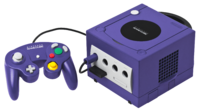 | |||||||||||||
Available colors:
| |||||||||||||
| Manufacturer | Nintendo | ||||||||||||
|---|---|---|---|---|---|---|---|---|---|---|---|---|---|
| Type | Home console | ||||||||||||
| Release date(s) | |||||||||||||
| Media | GameCube Game Disc, Game Pak (Game Boy Player required) | ||||||||||||
| Input | Nintendo GameCube Controller WaveBird Controller Game Boy Advance | ||||||||||||
| Predecessor | Nintendo 64 | ||||||||||||
| Successor | Wii | ||||||||||||
The Nintendo GameCube[nb 1] (officially abbreviated as GCN) is a home video game console created by Nintendo. It is the successor to the Nintendo 64 and predecessor to the Wii. The Nintendo GameCube is the first Nintendo console to use discs as its game type, albeit with discs similar to mini DVDs, as they were 8cm in diameter. In addition, the GameCube also introduced a variety of connectivity options to Nintendo consoles, and was the third Nintendo console, after the Nintendo 64DD, to support online play officially, via the Nintendo GameCube Broadband Adapter and Modem Adapter, although only a few games supported it. It also enabled connectivity to the Game Boy Advance to access exclusive features of certain games or to use the portable system as a controller for the Game Boy Player.
Animal Crossing, an expanded version of Doubutsu no Mori, was released on the GameCube in 2001 and was later expanded and re-released in Japan as Doubutsu no Mori e+ in 2003. Additionally, Super Smash Bros. Melee, which features trophies from the Animal Crossing series, was released on the console in 2001 and later became the console's best-selling game.
The console was released on September 14, 2001 in Japan, November 18, 2001 in North America, May 3, 2002 in Europe, and May 17, 2002 in Australia. The GameCube sold 21.74 million units worldwide, and was discontinued in mid-2007. The GameCube's games and controllers are also backwards-compatible with the original model of its successor, the Wii. Future Nintendo consoles, such as the Wii U and Nintendo Switch, only have support for the GameCube Controllers through the use of a USB adapter, although the Wii U can only use the GameCube Controllers for Super Smash Bros. for Wii U.
| Game | Image | Release date(s) |
|---|---|---|
| Super Smash Bros. Melee | 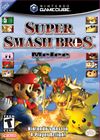 |
|
| Animal Crossing | 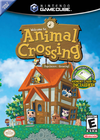 |
|
| Doubutsu no Mori e+ | 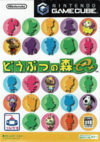 |
Game Boy Advance link cable
The Game Boy Advance link cable is a cable manufactured by Nintendo that allows connection between the Nintendo GameCube and Game Boy Advance. It is used in Animal Crossing to allow access to the island. The player can also play NES games on the GBA with it. With the cable, the player can also get designs for free, and design patterns at their house.
Appearances in the Animal Crossing series
- The Nintendo GameCube makes a cameo in Animal Crossing: Wild World, Animal Crossing: City Folk, and Animal Crossing: New Leaf. It appears in the Game Shelf (known as the Pink Box prior to New Leaf) furniture item alongside a controller and game. In New Leaf, customizing the Game Shelf produces the four different types of GameCube color variations released during its lifetime.
- A Nintendo GameCube furniture item appears in Animal Crossing: Pocket Camp.
- The GameCube Drawer (known as the GameCube Dresser in City Folk) appears as an item in Animal Crossing: City Folk and Animal Crossing: New Leaf - Welcome amiibo.
- It is also available to be downloaded via Wi-Fi within the game as a special item from Nintendo, serving as a storage device.
- In Animal Crossing, villagers (especially peppy villagers) may sometimes mention the Game Boy Advance link cable and its function, and will tell the player that they wish they had one.
The Pink Box in Wild World
The Pink Box in City Folk
The Pink Game Shelf in New Leaf, showing the purple GameCube.
Notes
External links
| Nintendo video game consoles | ||||||||||||||
|---|---|---|---|---|---|---|---|---|---|---|---|---|---|---|
| ||||||||||||||
